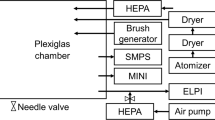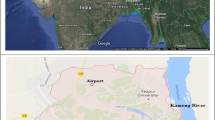Abstract
The SEM EDX backscattered electron (BSE) atomic number contrast has been largely used in this work, in combination with conventional secondary electron microanalysis, to investigate the presence of metal particles in airborne particulate collected at three sites (industrial, residential, and rural background) in the Po Valley (Italy). Individual particle x-ray microanalysis was used for this aim. In many cases, the presence of metal particles was not evident by secondary electron imaging and it was instead revealed by BSE detection. Metal particles were observed either as isolated (not clustered to other particles), or gathered together (homogeneous clusters). In addition, the BSE microanalysis put on evidence two main types of association of metals to other particulate components: heterogeneous clusters and metals embedded or enclosed in other materials. In this study, the first association (heterogeneous clusters) was observed mostly between Fe-bearing metallic particles and soot aggregates (or other carbonaceous particles) and it was found in the particulate matter (PM) of all studied sites. The second association, conversely, seems to be characterized by more selective relationships between composition/size of metal particles and type of other particulate components. These associations could be evidenced only when using the BSE Z-contrast and mainly concern three cases: (1) unusual silicate–carbonate mixed aggregates were observed at the industrial site only. In these aggregates, embedded Mn, Cr, Co, Bi, W, and Zr fine particles were selectively observed. (2) Ni and V rich ultrafine particles were only observed as embedded particles in the surface structure of carbon cenospheres. (3) Pb or Pb–Zn bearing fine and ultrafine particles were largely detected only in oxygenated organic aerosols in the ultrafine PM.




Similar content being viewed by others
References
Armiento G, Inglessis M, Mazziotti Tagliani S, Montereali MR, Nardi E, Palleschi S, Piga, Sacco F, Silvestroni L, Gianfagna A (2013) A comprehensive approach to the investigation of atmospheric particulate PM2.5: preliminary results. Periodico di Mineralogia 82(1):199–216
Basart S, Pérez C, Nickovic S, Cuevas E, Baldasano JM (2012) Development and evaluation of the BSC-DREAM8b dust regional model over Northern Africa, the Mediterranean and the Middle East. Tellus 64:1–23
Canepari S, Padella F, Astolfi ML, Marconi E, Perrino C (2013a) Elemental concentration in atmospheric particulate 1 matter: 2 estimation of nanoparticle contribution. Aerosol Air Qual Res. doi:10.4209/aaqr.2013.03.0081
Canepari S, Astolfi M.L., Farao C., Maretto M., Frasca D., Marcoccia M. and Perrino C. (2013b) Seasonal variations in the chemical composition of particulate matter: a case study in the Po Valley. Part II: : concentration and solubility of micro- and trace- elements. (In press.)
Cho WS, Duffin R, Thielbeer F, Bradley M, Megson IL, MacNee W, Poland CA, Tran CL, Donaldson K (2012) Zeta potential and solubility to toxic ions as mechanisms of lung inflammation caused by metal/metal oxide nanoparticles. Toxicol Sci 126:469–477
Cohen DD, Bailey GM, Kondepudi R (1996) Elemental analysis by PIXE and other IBA techniques and their application to source fingerprinting of atmospheric fine particle Pollution. Nucl Inst Methods Phys Res B 109/110(1996):218–226
Conny JM, Norris GA (2011) Scanning electron microanalysis and analytical challenges of mapping elements in urban atmospheric particles. Environ Sci Technol 45:7380–7386. doi:10.1016/j.aca.2013.02.008
Drewnick F, Schwab JJ, Jayne JT, Canagaratna M, Worsnop DR, Demerjian KL (2004) Measurement of ambient aerosol composition during the PMTACS-NY 2001 Using an aerosol mass spectrometer. Part I: mass concentrations. Aerosol Sci Technol 38(S1):92–103
Egerton RF (2005) Physical Principles of Electron Microscopy. Springer, ISBN-10: 0-387-25800-0
Finlayson-Pitts BJ, Pitts JN (2000) Chemistry of the upper and lower atmosphere. Academic Press, Waltham ISBN 0 12 257060-x
Goeke R S and Datye A K (2007) Model oxide supports for studies of catalyst sintering at elevated temperatures. Topics in Catalysis 46 (1–2)
Harrison RM, Jones AM, Lawrence RG (2003) A pragmatic mass closure model for airborne particulate matter at urban background and roadside sites. Atmos Environ 37:4927–4933
Hays MD, Beck L et al (2009) Physical and chemical characterization of residual oil-fired power plant emissions. Energy Fuel 23:2544–2551
Heinrich, K.F.J. (1966) in: Pye K, Boggs S Jr, Tovey N. K (1998) Backscattered Scanning Electron Microscopy and Image Analysis of Sediments and Sedimentary Rocks. Cambridge University Press
Helas G, Andreae MO (2008) Surface features on Sahara soil dust particles made visible by atomic force microscope (AFM) phase images. Atmos Meas Tech 1:1–8
Iordanidis A, Buckman J, Triantafyllou AG, Asvesta A (2008) Fly ash-airborne particles from Ptolemais–Kozani area, northern Greece, as determined by ESEM-EDX. Int J Coal Geol 73:63–73
Kandler K, Benker N, Bundke U, Cuevas E, Ebert M, Knippertz P et al (2007) Chemical composition and complex refractive index of Saharan Mineral Dust at Izan˜ a, Tenerife (Spain) derived by electron microscopy. Atmos Environ 41:8058–8074
Kandler K, Schutz L, Deutscher C, Ebert M, Hofmann H, Jackel S, Jaenicke R, Knippertz P, Lieke K, Massling A, Petzold A, Schladitz A, Weinzierl B, Wiedensohler A, Zorn S, Weinbruch S (2009) Size distribution, chemical and mineralogical composition and derived optical parameters of the boundary layer aerosol at Tinfou, Morocco, during SAMUM 2006. Tellus B 61:32–50
Kertesz Z, Szikszai Z, Szoboszlai Z, Simon A, Huszank R, Uzonyi I (2009) Study of individual atmospheric aerosol particles at the Debrecen ion microprobe. Nucl Inst Methods Phys Res B 267:2236–2240
Kulkarni P, Baron PA, Willeke K (eds) (2011) Aerosol measurement: principles, techniques, and applications, 3rd edn. Wiley, Hoboken
Ledoux F, Laversin H, Courcot D, Courcot, Zhilinskaya EA, Puskaric E, Aboukaïs A (2006) Characterization of iron and manganese species in atmospheric aerosols from anthropogenic sources. Atmos Res 82:622–632
Lloyd GE (1987) Atomic number and crystallographic contrast images with the SEM: a review of backscattered electron techniques. Mineral Mag 51:3–19
Lucarelli F, Nava S, Calzolai G, Chiari M, Udisti R, Marino F (2011) Is PIXE still a useful technique for the analysis of atmospheric aerosols? The LABEC experience. X-Ray Spectrom 40:162–167
Moffet RC, Desyaterik Y et al (2008) Characterization of aerosols containing Zn, Pb, and Cl from an industrial region of Mexico City. Environ Sci Technol 42:7091–7097
Moldanova J, Fridell E, Popovicheva O, Demirdjian B, Tishkova V, Faccinetto A, Focsa C (2009) Characterisation of particulate matter and gaseous emissions from a large ship diesel engine. Atmos Environ 43:2632–2641
Moreno T, Pandolfi M, Querol X, Lavín J, Alastuey A, Viana M, Gibbons W (2011) Manganese in the urban atmosphere: identifying anomalous concentrations and sources. Environ Sci Pollut Res 18:173–183
Moroni B, Viti C (2009) Grain size, chemistry, and structure of fine and ultrafine particles in stainless steel welding fumes. Aerosol Sci 40:938–949
Moroni B, Cappelletti D, Marmottini F, Scardazza F, Ferrero L, Bolzacchini E (2012) Integrated single particle-bulk chemical approach for the characterization of local and long range sources of particulate pollutants. Atmos Environ 50:267–277
Mukhtar, A., Limbeck, A. (2013). Recent developments in assessment of bio-accessible trace metal fractions in airborne particulate matter: a review. Analytica Chimica Acta, In press
Namorka E, Johansen BV, Løvik M (2006) Detection of allergens adsorbed to ambient air particles collected in four European cities. Toxicol Lett 165:71–78
Pant P, Harrison RM (2012) Critical review of receptor modelling for particulate matter: a case study of India. Atmos Environ 49(2012):1–12
Perrino C, Pietrodangelo A, Febo A (2001) An atmospheric stability index based on radon progeny measurements for the evaluation of primary urban pollution. Atmos Environ 35:5235–5244
Perrino C, Canepari S, Cardarelli E, Catrambone M, Sargolini T (2008) Inorganic constituents of urban air pollution in the Lazio region (Central Italy). Environ Monit Assess 136:69–86
Perrino C, Catrambone M, Dalla Torre S, Rantica E, Sargolini T and Canepari S (2013) Seasonal variations in the chemical composition of particulate matter: a case study in the Po Valley. Part I: macro-components and mass closure ESPR. DOI 10.1007/s11356-013-2067-1
Reimer L (1998) Scanning electron microscopy: physics of image formation and microanalysis. Springer, New York
Seinfeld J H and Pandis S N (1998) Atmospheric chemistry and physics. Wiley ISBN 0 471 17815 2, Ch.2
Twohy C.H., Kreidenweis S.M., Eidhammer T., Browell E.V., Heymsfield A.J., Bansemer A.R., Anderson B.E., Chen G., Ismail S., DeMott P.J. and Van Den heever S.C. (2009). Geophysocal Research Letters 36, DOI. 10.1029/2008GL035846
UNEP (2006). Global desert outlook. Chapter 3. Deserts and the planet—linkages between deserts and non-deserts.
Vester BP, Ebert M, Barnert EB, Schneider J, Kandler K, Schutz L, Weinbruch S (2007) Composition and mixing state of the urban background aerosol in the Rhein-Main area (Germany). Atmos Environ 41:6102–6115
Viana M, Kuhlbusch TAJ, Querol X, Alastuey A, Harrison RM, Hopke PK et al (2008) Source apportionment of particulate matter in Europe: a review of methods and results. Aerosol Sci 39:827–849
Witt MLI, Meheran N, Mather TA, De Hoog JCM, Pyle DM (2010) Aerosol trace metals, particle morphology and total gaseous mercury in the atmosphere of Oxford, UK. Atmos Environ 44:1524–1538
Zhang J, Provis JL, Feng D, van Deventer JSJ (2008) Geopolymers for immobilization of Cr6+, Cd2+, and Pb2+. J Hazard Mater 157:587–598
Acknowledgments
This study has been funded by HERA s.p.a.
Author information
Authors and Affiliations
Corresponding author
Additional information
Responsible editor: Vera Slaveykova
Rights and permissions
About this article
Cite this article
Pietrodangelo, A., Pareti, S. & Perrino, C. Improved identification of transition metals in airborne aerosols by SEM–EDX combined backscattered and secondary electron microanalysis. Environ Sci Pollut Res 21, 4023–4031 (2014). https://doi.org/10.1007/s11356-013-2261-1
Received:
Accepted:
Published:
Issue Date:
DOI: https://doi.org/10.1007/s11356-013-2261-1




